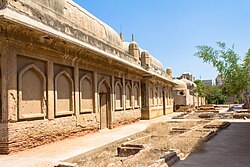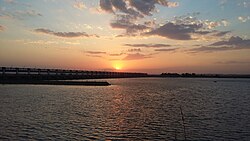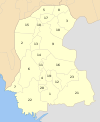world.wikisort.org - Pakistan
Hyderabad District (Sindhi: ضلعو حيدرآباد Urdu: ضلع حیدرآباد),![]() pronunciation (help·info) is a district of Sindh, Pakistan. Its capital is the city of Hyderabad. The district is the second most urbanized in Sindh, after Karachi, with 80% of its residents live in urban areas.[2]
pronunciation (help·info) is a district of Sindh, Pakistan. Its capital is the city of Hyderabad. The district is the second most urbanized in Sindh, after Karachi, with 80% of its residents live in urban areas.[2]
Hyderabad district
| |
|---|---|
District of Sindh | |
Top: Tombs of Talpur Mirs Bottom: Kotri Barrage | |
 Map of Sindh with Hyderabad District highlighted | |
| Country | |
| Province | |
| Division | Hyderabad |
| Established | 1843 |
| Founded by | British government |
| Headquarters | Hyderabad |
| Government | |
| • Type | District Administration |
| • Deputy Commissioner | N/A |
| • District Police Officer | N/A |
| • District Health Officer | N/A |
| Area | |
| • Total | 993 km2 (383 sq mi) |
| Population (2017)[1] | |
| • Total | 2,199,928 |
| • Density | 2,200/km2 (5,700/sq mi) |
| Time zone | UTC+5 (PKT) |
| Number of Tehsils | 4 |
| Website | www.hyderabad.gov.pk |
History
The East India Company occupied Sindh in 1843; They formed three districts in Sindh administratively: Hyderabad, Karachi and Shikarpur (now Sukkur district).
In 1982, the largest area of the district in eastern side bifurcated to create a new district Thar and Parkar district with the headquarters Umerkot.
In 1907, create a new taluka named Nasrat from Sakrand and Shahdadpur taluka.
In 1912, the northern side of the district separated to form Nawabshah district.
In 1975, Southern side also separated to form Badin district.
After 1998 census, two new talukas created in the district named; Hyderabad city and Latifabad talukas.
After 2002 elections, a new taluka created in the district named Qasimabad from Hyderabad City taluka.
The city of Hyderabad is where the district headquarters were located and the district government used to be seated. The last Deputy Commissioner of the district was Rizwan Ahmed. Until the early 1970s the district included all the four districts mentioned above as well as the Badin district. This administrative setup was demolished by former President Pervez Musharraf in 2001 when he introduced the local body government.
In 2005, three new districts - Tando Muhammad Khan, Matiari and Tando Allahyar districts were formed out of Hyderabad district.[3]
Geography
Hyderabad District is 104,877 hectares in size.[4] 14,250 hectares of the district are under wheat cultivation, with a total annual production of over 55,000 tonnes.[4]
Administration and government
The district Administration is given below:
Demographics
| Year | Pop. | ±% p.a. |
|---|---|---|
| 1972 | 814,060 | — |
| 1981 | 1,005,460 | +2.37% |
| 1998 | 1,494,866 | +2.36% |
| 2017 | 2,199,928 | +2.05% |
| Sources:[5] | ||
At the time of the 2017 census, Hyderabad district had a population of 2,199,928, of which 1,145,216 were males and 1,054,407 females. The rural population was 373,410 (16.97%) and urban 1,826,518 (83.03%). The literacy rate is 65.76%: 69.91% for males and 61.23% for females.[1]
Religion
The majority religion is Islam, with 90.86% of the population. Hinduism (including those from Scheduled Castes) is practiced by 8.22%, while Christianity is practiced by 0.86% of the population.[1]
Language
At the time of the 2017 census, 43.44% of the population spoke Sindhi, 42.61% Urdu, 4.45% Punjabi, 3.22% Pashto and 1.22% Saraiki as their first language.[1]
List of Dehs
The following is a list of Hyderabad District's dehs, organised by taluka:[6]
- Hyderabad Taluka (70 dehs)
- Abri
- Agheemani
- Almani
- Alni
- Amilpur
- Barechani
- Barham
- Bhido Jagar
- Bhido Rayati
- Bhinpur
- Bilori
- Bohiki
- Boochki Jagir
- Boochki Rayati
- Buxo laghari
- Chacha Detha
- Chukhi
- Dachrapur
- Dali Nandi
- Dali Wadi
- Damanchani Rayati
- Dhamanchani Jagir
- Ghaliyoon
- Ghotana
- Gujjan
- Gul Mohd Thoro
- Halepota
- Hatri
- Hotki
- Hussain Khan Thoro
- Kajhur
- Kathri
- Kathro
- Khanpota
- Khunjejani
- Kunner
- Lashari
- Liyar Jagir
- Mati
- Miyano
- Moharo
- Moolan
- Mori Jagir
- Mori Rayati
- Mulki
- Narejani
- Noorai Jagir
- Noorai Rayati
- Panhwari
- Pasaikhi
- Patbhari
- Patoro
- Raees
- Rahooki
- Rajpari
- Rukanpur
- Sahita
- Sanhwar
- Seri Jagir
- Seri Rayati
- Sipki Jagir
- Sipki Rayati
- Sukhpur
- Takio Jeewan Shah Jagir
- Takio Jeewan Shah Rayati
- Tando Fazal
- Tando Qaiser
- Thaheem
- Theba
- Widh
- Qasimabad Taluka (4 dehs)
- Jamshoro
- Mirzapur
- Sari
- Shah Bukhari
- Latifabad Taluka (10 dehs)
- Bora reyati
- Ganjo Takar
- Giddu Bandar
- Goondar
- Khater
- Lakhi Keti
- Malh
- Mehrani
- Met Khan
- Nareja
- Hyderabad City Taluka (4 dehs)
- Foujgah
- Ghanghra
- Gujjo
- Hyderabad
See also
- Hyderabad, Sindh
- List of educational institutions in Hyderabad, Sindh
- Shiv temple, Hyderabad
Notes
References
- "District-wise Tables - Census 2017 Final Results". pbs.gov.pk. Pakistan Bureau of Statistics. 2017.
- Azfar, Sara. "SINDH SECONDARY CITIES URBAN SECTOR ASSESSMENT" (PDF). URBAN MUNICIPAL SERVICES. ASIAN DEVELOPMENT BANK. Archived from the original (PDF) on 26 February 2017. Retrieved 15 December 2017.
- "Three new districts carved out of Hyderabad". TheDawn. 5 April 2005. Retrieved 31 July 2021.
- Siyal, Altaf Ali (January 2015). "Remote Sensing and GIS based wheat crop acreage and yield estimation of district Hyderabad, Pakistan". Mehran University Research Journal of Engineering and Technology. Retrieved 14 December 2017.
- "Pakistan: Provinces and Districts". www.citypopulation.de.
- "List of Dehs in Sindh" (PDF). Sindh Zameen. Retrieved 22 March 2021.
Bibliography
- 1998 District census report of Hyderabad. Census publication. Vol. 59. Islamabad: Population Census Organization, Statistics Division, Government of Pakistan. 1999.
На других языках
[de] Hyderabad (Distrikt, Pakistan)
Der Distrikt Hyderabad ist ein Verwaltungsdistrikt in Pakistan in der Provinz Sindh. Sitz der Distriktverwaltung ist die gleichnamige Stadt Hyderabad.- [en] Hyderabad District, Sindh
[ru] Хайдарабад (округ)
Хайдарабад (урду ضِلع حیدرآباد, англ. Hyderabad District) — один из 23 округов пакистанской провинции Синд. Административный центр — город Хайдарабад.Другой контент может иметь иную лицензию. Перед использованием материалов сайта WikiSort.org внимательно изучите правила лицензирования конкретных элементов наполнения сайта.
WikiSort.org - проект по пересортировке и дополнению контента Википедии


